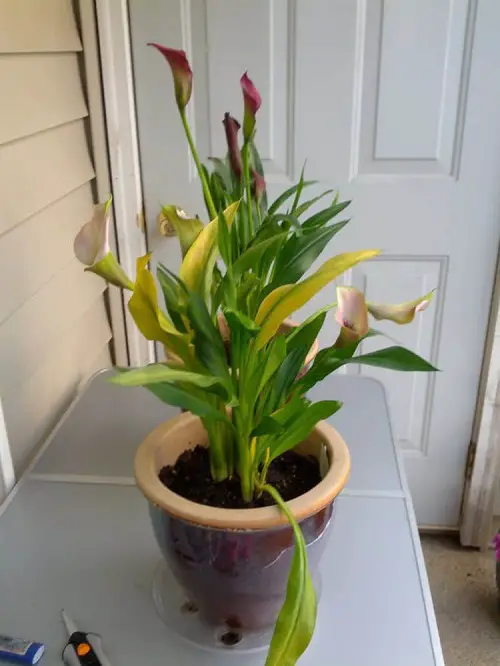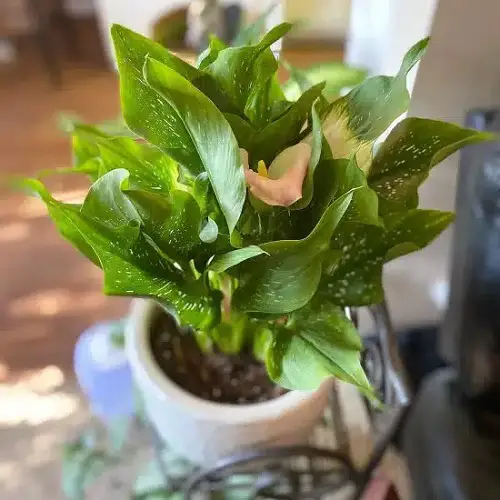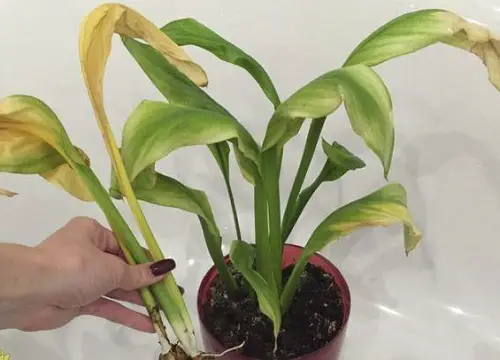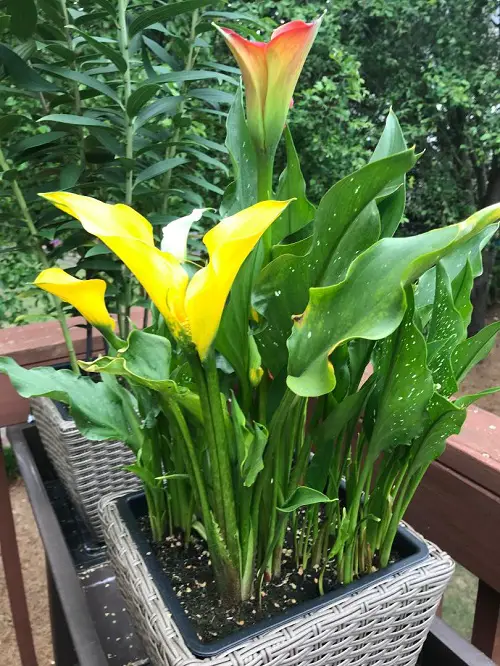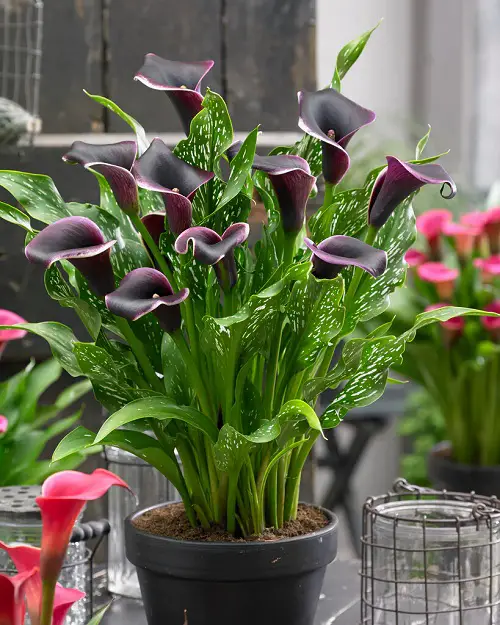Are you wondering – Why Are My Calla Lily Leaves Turning Yellow? We’ve got you covered with our detailed guide!
If you’re looking for the answer to “Why Are My Calla Lily Leaves Turning Yellow,” you’ve come to the right place. Let us explore the possible reasons behind yellowing Calla Lily leaves and effective solutions for getting them healthy and green again.
Why Are My Calla Lily Leaves Turning Yellow – Reasons and Solutions
# 1 Reason: Nutrient Deficiencies
Nutrient deficiencies can have a profound effect on the health and vitality of Calla Lily plants. In particular, deficiencies in key nutrients like nitrogen, iron, and magnesium can significantly impact their well-being and result in Calla Lily Leaves Turning Yellow.
Solution: Providing balanced fertilization and ensuring the presence of essential nutrients in the soil is crucial for preventing yellowing leaves. Regularly monitor the plant’s nutrient levels and adjust fertilization.
Here are Effective Homemade Lawn Fertilizers That Are Safe From Hazardous Chemicals
# 2 Reason: The Dangers of Over and Underwatering
Overwatering is a frequently encountered issue that can lead to yellowing leaves in Calla Lilies. When the plants receive excessive moisture, it can have detrimental effects on their health and result in root rot, which can ultimately lead to leaf discoloration.
Conversely, underwatering can also cause yellowing leaves. Calla lilies require consistent moisture, so ensure that you are providing adequate water. Water deeply when the top inch or so of soil feels dry.
Solution: To prevent overwatering, allow the top inch of soil to dry between waterings, ensure proper drainage, and consider using well-draining soil or adding perlite to the planting mix.
Here are Signs of Overwatering & How to Save an Overwatered Plant
# 3 Reason: Soil and pH Imbalance
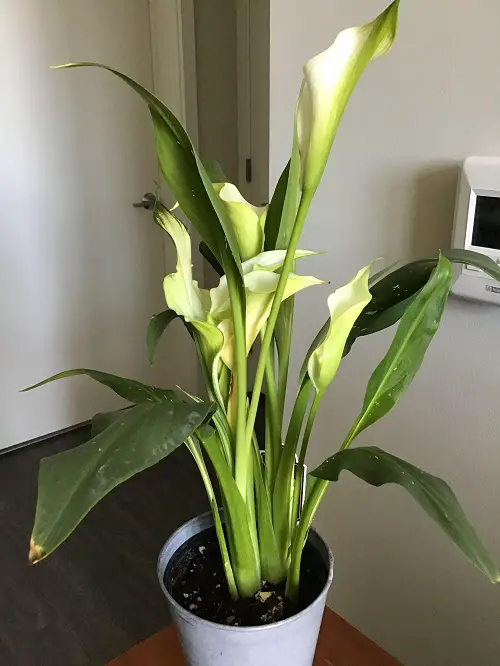
An imbalanced soil pH can also result in yellowing leaves. Calla Lilies prefer slightly acidic soil (pH 6.0-6.5), and deviations from this range can hinder nutrient absorption.
Solution: You should conduct a soil test to determine the pH level and make necessary amendments using organic matter or soil additives to adjust the pH and promote healthier foliage.
Check out a Weird Soil Test that can help you here
# 4 Reason: Preventing Yellowing Leaves Due to Over-fertilization
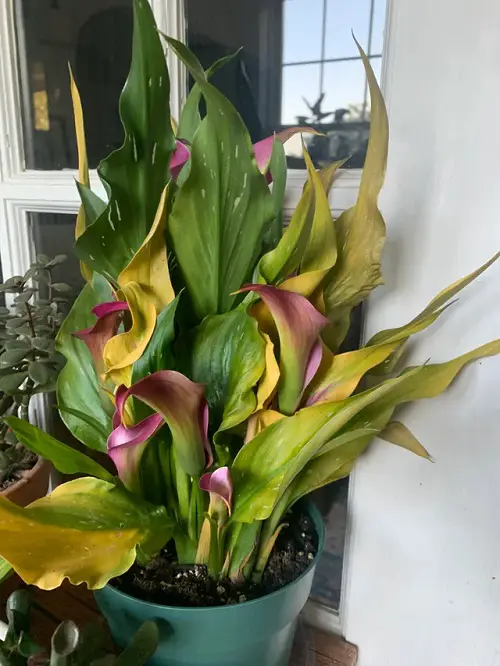
Maintaining the right balance of nutrients is crucial for the health of Calla Lilies. Over-fertilization is another reason behind Calla Lily Leaves Turning Yellow as plants struggle to absorb the excessive nutrients.
Solution: Start fertilizing calla lilies in early spring, just as new growth emerges. Avoid fertilizing during the dormant period or when the plant is not actively growing. Use a balanced formula like a 10-10-10 or 14-14-14 feed. Dilute it to half of its strength and feed every 4-6 weeks during the growing season.
# 5 Reason: Pest Infestations
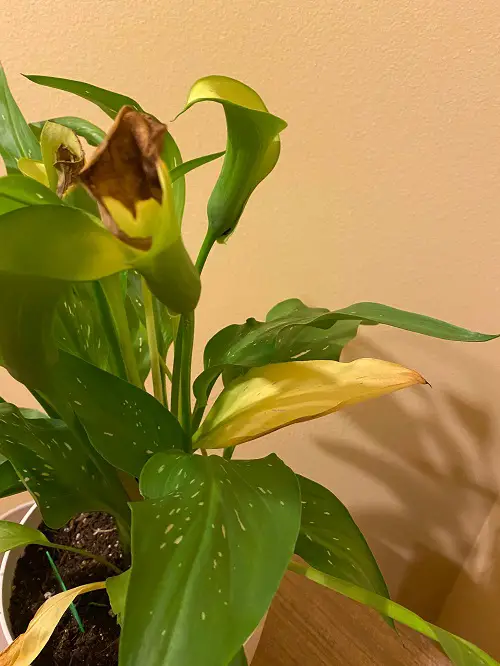
Pest infestations pose a significant threat to the health of Calla Lilies and can contribute to yellowing leaves. Common pests, such as aphids, spider mites, or fungal diseases, can weaken the plants and cause leaf discoloration.
To protect your Calla Lilies, it’s essential to inspect them for signs of pests or diseases regularly.
Solution: If you detect any infestation, take appropriate measures for control. Organic pest control methods, such as using neem oil or insecticidal soap, can effectively combat pests without harming beneficial insects. By addressing pest issues promptly, you can prevent yellowing leaves and promote the overall vitality of your Calla Lilies.
# 6 Reason: Environmental Stressors
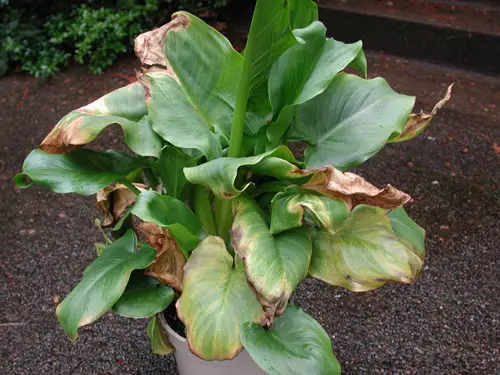
The amount of sunlight and exposure to heat can influence the appearance of Calla Lily leaves. Excessive sunlight and high temperatures can cause yellowing and even scorching of the leaves.
Solution: It’s important to provide partial shade for the plants during the hottest parts of the day, particularly in regions with intense sunlight. If possible, place your calla lilies where they can receive morning sunlight and be shaded from the intense afternoon sun. Morning sun is typically less intense and will help promote healthy growth without causing sunburn.
# Reason 7: Transplantation and Root Health

During the process of transplanting or improper handling, Calla Lilies can suffer from root damage, leading to yellowing leaves. Furthermore, any other physical damage to the roots during improper handling can also result in yellowing leaves.
Solution: You should handle the plants gently during transplantation, ensuring the roots are not injured or disturbed. Using high-quality, well-draining soil during transplantation is also crucial. This type of soil promotes healthy root development and minimizes the risk of Calla Lily Leaves Turning Yellow due to stress.
#Reason 8:Dormancy
Calla lilies naturally go through a period of dormancy, typically during the winter months. Yellowing leaves may occur as part of this process.
Solution: Reduce watering and allow the plant to rest during this period. New growth should emerge in due course.
Here is How to Reduce Transplant Shock
Is Yellowing Leaves a Sign of a Calla Lily Disease?
Yes, yellowing leaves can be a sign of a disease in Calla Lilies. There are several diseases that can affect Calla Lilies and cause leaf yellowing.
1. Root Rot
This fungal disease occurs when the soil is overly saturated and poorly drained, leading to the decay of the roots. As a result, the plant may exhibit yellowing leaves, wilting, and stunted growth.
Here is How to Treat Root Rot in Houseplants Like a Pro
2. Leaf Spot
Leaf spot diseases are caused by various fungi or bacteria. These diseases typically manifest as circular or irregular-shaped spots on the leaves, which can turn yellow or brown. Over time, the affected leaves may drop prematurely.
3. Bacterial Soft Rot
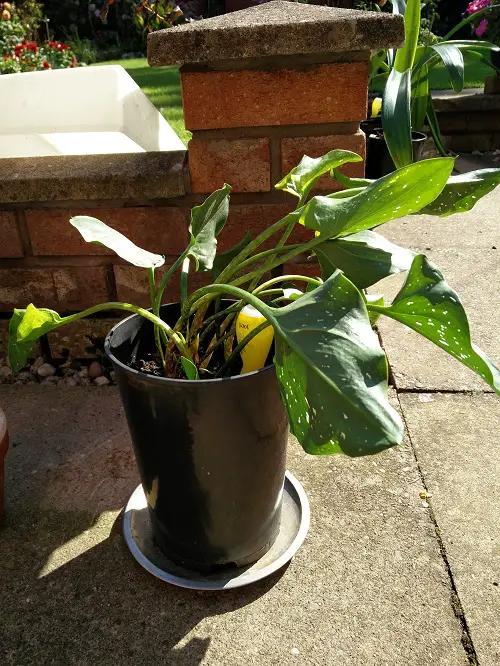
This bacterial infection causes soft, watery decay in the plant’s tissues, including the leaves. The infected leaves may turn yellow, become mushy, and emit a foul odor.
Note: If you notice your Calla Lily Leaves Turning Yellow, look for spots, lesions, or other abnormalities on the leaves, stems, and roots. If you suspect a disease, you should consult with a local plant expert or horticulturist for an accurate diagnosis and appropriate treatment options.
Orchid Leaves Turning Yellow? Follow these Tips
Quick Tips to Control Calla Lily Leaves Turning Yellow
To ensure healthy growth and prevent the yellowing of Calla Lily leaves, it is crucial to provide the plant with suitable conditions and care.
- Place the Calla Lily in a bright location with indirect sunlight for at least 5-7 hours a day.
- Water the plant when the top inch of soil feels dry, but avoid overwatering, as it can lead to root rot.
- Calla Lilies prefer a humid environment, so mist the leaves regularly or place a tray with water near the plant to increase humidity.
- Plant the Calla Lily in a well-draining potting mix that allows excess water to escape, preventing waterlogged soil.
- Feed the plant with a balanced, water-soluble fertilizer once every 2-4 weeks during the growing season (spring to fall) to provide essential nutrients.
- During the winter months, the plant may naturally go into dormancy. Reduce watering and place it in a cooler area (around 50°F or 10°C) to allow it to rest.
- Avoid rough handling of the plant, as it can damage the leaves and lead to stress, which may cause yellowing.
- Ensure proper drainage by using pots with drainage holes or adding a layer of gravel at the bottom to prevent excess water accumulation.
- Protect the Calla Lily from cold or hot drafts, as they can cause stress to the plant and result in yellowing leaves.
Monstera Leaves Turning Yellow? Reasons and Solutions here
Frequently Asked Questions
1. How Can I Prevent Nutrient Deficiencies in My Calla Lilies?
To prevent nutrient deficiencies, regularly fertilize your Calla Lilies with a balanced fertilizer formulated for these plants. Look for a fertilizer with an equal or near-equal ratio of nitrogen (N), phosphorus (P), and potassium (K). These essential nutrients support plant health and encourage robust foliage and vibrant blooms.
Note: Avoid over-fertilizing, as excessive nutrients can lead to nutrient imbalances, yellowing leaves, or even damage to the plants.
2. Should I Remove Yellowing Leaves From My Calla Lily Plants?
Absolutely! Removing yellowing leaves from your Calla Lily plants is recommended. Simply trim the affected leaves near the base using clean and sharp pruning shears. This practice helps maintain the health and appearance of the plants.
3. What Is the Ideal Temperature Range for Calla Lilies?
Calla Lilies thrive in temperatures ranging from 65°F to 75°F (18°C to 24°C). It’s important to avoid exposing them to extreme heat or cold, as such conditions can contribute to leaf yellowing and stress the plants.
4. Can I Propagate Calla Lilies to Replace Yellowing Plants?
Yes, you can propagate Calla Lilies to replace yellowing plants. Propagation can be done through division or by planting bulb offsets. This allows you to replace unhealthy plants with new, healthy ones and maintain a vibrant and flourishing garden display.



